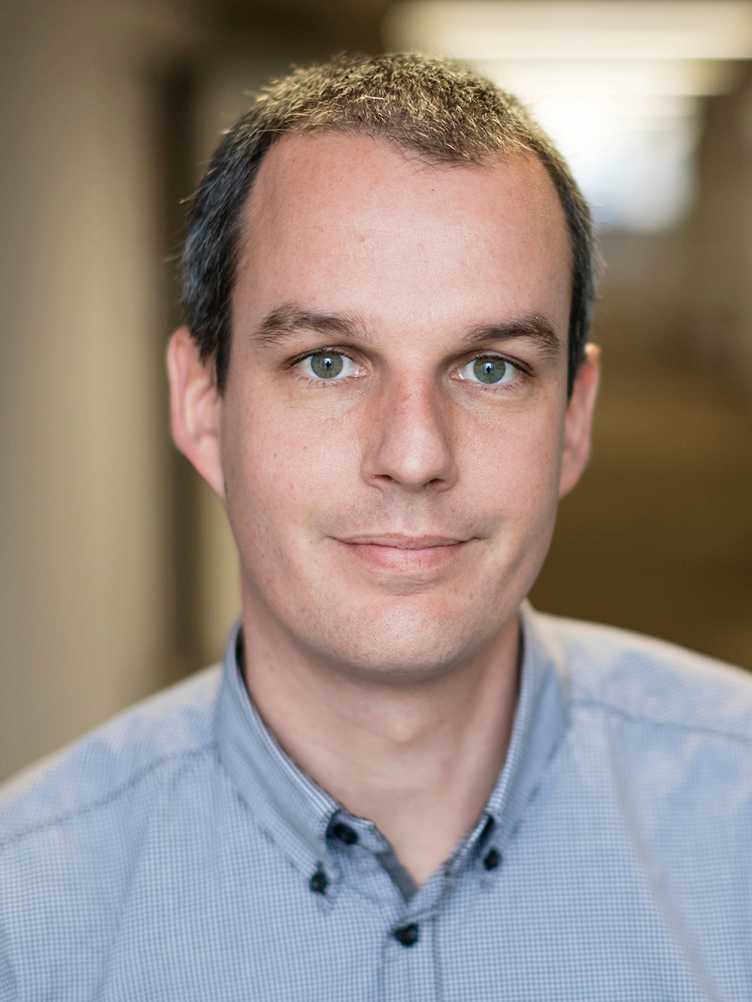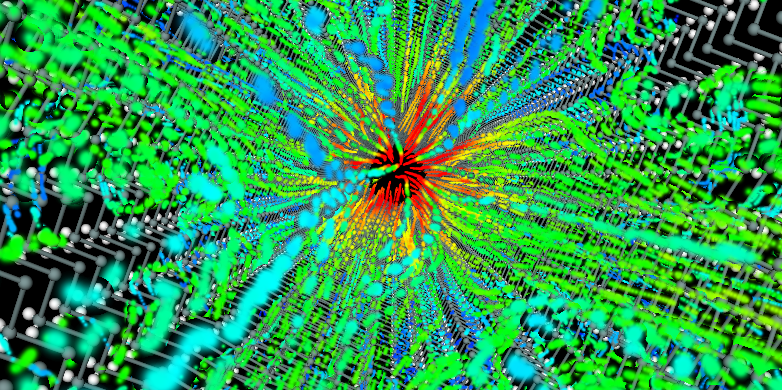"In nanoelectronics we work in a similar way to architects"
Prof. Mathieu Luisier heads the "Computational Nanoelectronics" group at the Institute of Integrated Systems. In our interview, the "Golden Owl" winner talks about the challenges of nanotechnology and about how he, as a former D-ITET graduate, perceives the department and its development. In the spring semester, he gives the lecture "Applications of Thermal Modelling: From Hot Atoms to Heated Tissues", in which there are still free places. It's worth dropping by!
Prof. Luisier, what is your research focus?

Officially, my professorship is called "Rechnergestützte Modellierung von nanoskaligen Bauelementen", but I think the English description "Computational Nanoelectronics" is more accurate.
Specifically, we develop physical models and implement them in a simulator we developed to investigate the behaviour of electrical, optical and thermal components, such as transistors, light-emitting diodes or memory cells. Our goal is to predict the property of such nanostructures before they are manufactured. In this way, we want to support the work of experimental research groups. Our role is very similar to that of an architect: before a house is built, it is virtually constructed on a computer. We do the same for the design of nanoscale components, with the difference that we develop the necessary software ourselves.
What brought you to this field?
A coincidence, I would say! During high school, I worked at the local electricity provider in my home town. This awakened my interest in energy transmission in particular. Then, when I was a student at ETH, I became enthusiastic about optoelectronic components and wanted to deepen my knowledge in this direction. That's why I chose a lecture on this topic. Prof. Heinz Jäckel was announced as the lecturer. But Prof. Wolfgang Fichtner, one of the pioneers of computer-aided modelling of components, turned up. I was very fascinated by his work. I then completed a semester thesis, my diploma thesis and even my dissertation with him.
What do you see as the biggest changes and developments in the department since you graduated?
Since I graduated in 2003, the department has grown and new research topics and lectures have been added, for example in the fields of hardware security, distributed computing, neurosciences, ultra-low-power electronics, bioelectronics etc. During my studies, I was almost exotic as a "Romand", but today there is much more diversity, both among the students and the professors. The structure of the degree programme has also changed: I belong to the last generation that did a diploma instead of a Master's degree.
With our research activity, we can simplify the design of current and future transistors, especially in the nanometre range, where quantum mechanical effects also come into play. Prof. Mathieu Luisier
What impact does your research have on society?
I think our research definitely has an indirect impact: We are currently suffering from a shortage of electronic components. One of the reasons is that there are only three companies left in the world that can produce "state-of-the-art" integrated circuits (Intel, Samsung and TSMC) because this task has become so complex and expensive. When I started in this field, there were still more than 20 companies. With our research activity, we can simplify the design of today's and tomorrow's transistors, especially in the nanometre range, where quantum mechanical effects also come into play. These devices form the core of all integrated circuits.
What are currently the biggest challenges in your field of research?
We want to simulate nanoscale devices as accurately as possible so that our predictions correspond to reality. As with weather forecasts, we have to make many assumptions for this in order to keep the simulation computing times low. For this reason, we may under- or overestimate certain effects, which can be problematic. When this happens, we have to go back to our models and improve them so that we can reproduce the measurements that are available to us - if not in terms of quantity, then at least in terms of quality.
A challenge for the entire industry is the current shortage of electronic components, which has already been mentioned. The "Chips Act" initiated by the EU to promote the development and production of microchips in Europe could be a solution to this. I hope that this measure will strengthen the semiconductor industry and the entire associated ecosystem in Europe, from the training of qualified personnel to manufacturing.
How do you like ETH as a research institution?
Very much. We have almost unlimited freedom: we can decide ourselves which research projects we do, which lectures we give, who we collaborate with at ETH or outside, and how our group is structured. I can't judge what it's like at other universities, but I can say that I have found optimal conditions for my work at ETH.
With which colleagues inside and outside the department do you have collaborations?
It would take too long to list all the collaborations (laughs). I will limit myself to those near Zurich. In the department, I work with almost all colleagues who build nanoscale devices, such as Prof. Bolognesi, Grossner, Leuthold, Novotny, Wood and Yarema. I also worked with Prof. Benini and Prof. Hoefler from D-INFK on optimising numerical algorithms. This has helped us to speed up our in-house device simulator. In addition, there are collaborations with a few companies, such as IBM and SPEAG.
What is the composition of your group? Are you looking for doctoral students?
My group is divided into five sub-groups. I am responsible for all of them, but four of them are supervised by one research scientist each, the last one by me personally. Here is an overview: Prof. Andreas Schenk's "Device Physics" group, Dr. Mauro Ciappa's "Physical Characterization" group, Dr. Alexandros Emboras' "Brain-inspired Devices and Circuits" group, Dr. Thomas Burger's "Analog Circuit" group and last but not least my own "Nano-device Simulations" group. In total, we have about 20 doctoral students and three post-docs. A little less than half come from Switzerland, the rest from Europe and all over the world.
What lectures are you giving this semester and next semester?
This semester I'm giving two lectures:
"Semiconductor Devices: Quantum Transport at the Nanoscale". This is a lecture in the Master's programme. I have been giving it for ten years and started with ten students. Today there are more or less 40.
Together with Dr. Esra Neufeld from the IT'IS Foundation, we will give the lecture "Applications of Thermal Modelling: From Hot Atoms to Heated Tissues" for the third time. It is a very exciting lecture in which we show how heat can/must be precisely controlled to fight tumours or to optimally operate electronic devices.
In the autumn semester, together with Dr. Alexandros Emboras, I give the "Digital Circuits" lecture and the accompanying practical course for the first-year students.
Will the corona crisis change teaching permanently? Do you think that you will increasingly use digital learning environments and forms in your lectures in the future?
I think so, yes. In the future, it is very likely that many lectures will continue to be recorded. Especially for large courses, it might even be better for some students if they can study at home and only have to come to ETH to do practical courses, P&S etc. or to attend lectures that cannot be transmitted online perfectly. Personally, I am fine with the hybrid format.

